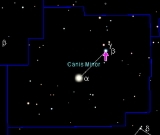
Beta Canis Minoris
Encyclopedia
Beta Canis Minoris (β CMi, β Canis Minoris) is a star
in the constellation
of Canis Minor
. It has the traditional name Gomeisa.
Beta Canis Minoris is a hot, B8-class
main sequence
star
of apparent magnitude
2.9, easily visible to the naked eye. It is slightly variable
, and belongs to the Gamma Cassiopeiae category of variable stars. This star is rotating rapidly and is surrounded by a disk of material, which the emissions are heating up.
The traditional name is from the Arabic
al-ghumaisa’ "the bleary-eyed (woman)", short for مرزم الغميصاء mirzam al-ghumaisa’ "girdle of the bleary-eyed one". In Arabic, the short form would be identical with the name of Procyon
.
In Chinese
, , meaning South River
, refers to an asterism
consisting of β Canis Minoris, Procyon
and ε Canis Minoris
. Consequently, β Canis Minoris itself is known as
Star
A star is a massive, luminous sphere of plasma held together by gravity. At the end of its lifetime, a star can also contain a proportion of degenerate matter. The nearest star to Earth is the Sun, which is the source of most of the energy on Earth...
in the constellation
Constellation
In modern astronomy, a constellation is an internationally defined area of the celestial sphere. These areas are grouped around asterisms, patterns formed by prominent stars within apparent proximity to one another on Earth's night sky....
of Canis Minor
Canis Minor
Canis Minor is a small constellation. It was included in the 2nd century astronomer Ptolemy's 48 constellations, and is still included among the 88 modern constellations...
. It has the traditional name Gomeisa.
Beta Canis Minoris is a hot, B8-class
Stellar classification
In astronomy, stellar classification is a classification of stars based on their spectral characteristics. The spectral class of a star is a designated class of a star describing the ionization of its chromosphere, what atomic excitations are most prominent in the light, giving an objective measure...
main sequence
Main sequence
The main sequence is a continuous and distinctive band of stars that appears on plots of stellar color versus brightness. These color-magnitude plots are known as Hertzsprung–Russell diagrams after their co-developers, Ejnar Hertzsprung and Henry Norris Russell...
star
Star
A star is a massive, luminous sphere of plasma held together by gravity. At the end of its lifetime, a star can also contain a proportion of degenerate matter. The nearest star to Earth is the Sun, which is the source of most of the energy on Earth...
of apparent magnitude
Apparent magnitude
The apparent magnitude of a celestial body is a measure of its brightness as seen by an observer on Earth, adjusted to the value it would have in the absence of the atmosphere...
2.9, easily visible to the naked eye. It is slightly variable
Variable star
A star is classified as variable if its apparent magnitude as seen from Earth changes over time, whether the changes are due to variations in the star's actual luminosity, or to variations in the amount of the star's light that is blocked from reaching Earth...
, and belongs to the Gamma Cassiopeiae category of variable stars. This star is rotating rapidly and is surrounded by a disk of material, which the emissions are heating up.
The traditional name is from the Arabic
Arabic language
Arabic is a name applied to the descendants of the Classical Arabic language of the 6th century AD, used most prominently in the Quran, the Islamic Holy Book...
al-ghumaisa’ "the bleary-eyed (woman)", short for مرزم الغميصاء mirzam al-ghumaisa’ "girdle of the bleary-eyed one". In Arabic, the short form would be identical with the name of Procyon
Procyon
Procyon is the brightest star in the constellation Canis Minor. To the naked eye, it appears to be a single star, the seventh brightest in the night sky with a visual apparent magnitude of 0.34...
.
In Chinese
Chinese language
The Chinese language is a language or language family consisting of varieties which are mutually intelligible to varying degrees. Originally the indigenous languages spoken by the Han Chinese in China, it forms one of the branches of Sino-Tibetan family of languages...
, , meaning South River
Well (Chinese constellation)
The Well mansion is one of the Twenty-eight mansions of the Chinese constellations. It is one of the southern mansions of the Vermilion Bird.-Asterisms:...
, refers to an asterism
Asterism (astronomy)
In astronomy, an asterism is a pattern of stars recognized on Earth's night sky. It may form part of an official constellation, or be composed of stars from more than one. Like constellations, asterisms are in most cases composed of stars which, while they are visible in the same general direction,...
consisting of β Canis Minoris, Procyon
Procyon
Procyon is the brightest star in the constellation Canis Minor. To the naked eye, it appears to be a single star, the seventh brightest in the night sky with a visual apparent magnitude of 0.34...
and ε Canis Minoris
Epsilon Canis Minoris
Epsilon Canis Minoris is a star in the constellation Canis Minor.ε Canis Minoris is a yellow G-type bright giant with an apparent magnitude of +4.99. It is approximately 990 light years from Earth....
. Consequently, β Canis Minoris itself is known as

